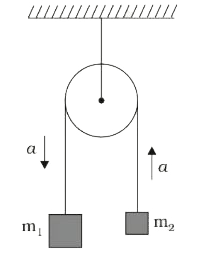A body A of mass M while falling vertically downwards under gravity breaks into two parts, a body B of mass 1/3 M and a body C of mass 2/3 M. The centre of mass of bodies B and C taken together shifts compared to that the body A towards
depends on height of breaking
does not shift
body C
body B
The correct Answer is:B
Since, the acceleration of centre of mass in both the case is same equal to g, so the centre of the bodies B& C taken together does not shift compared to that of body A.
Similar Questions
A body A of mass M while falling wertically downwards under gravity brakes into two parts, a body B of mass 13 M and a body C of mass 23 M. The center of mass of bodies B and C taken together shifts compared to that of body A towards
View SolutionA body falling vertically downwards under gravity breaks in two parts of unequal masses. The centre of mass of the two parts taken together shifts horizontally towards
View Solution
Knowledge Check
A body A of mass M while falling wertically downwards under gravity brakes into two parts, a body B of mass 13 M and a body C of mass 23 M. The center of mass of bodies B and C taken together shifts compared to that of body A towards
Adoes not shiftBdepends on height of breakingCbody BDbody COn a straight line passing through the foot of a tower, two points C and D are at distances of 4 m and 16 m from the foot respectively. If the angles of elevation from C and D of the top of the tower are complementary, then find the height of the tower.
ABody CBBody BCDepends on height of breakingDDoes not shiftA body falling vertically downwards under gravity breaks in two parts of unequal masses. The centre of mass of the two parts taken together shifts horizontally towards
Aheavier pieceBlighter pieceCdoes not shift horizontallyDdepends on the verical velocity at the tiem of breaking
A body falling vertically downwards under gravity breaks in two parts of unequal masses. The centre of mass of the two parts taken together shifts horizontally towards
View SolutionTwo bodies of masses m1andm2(<m1) are connected to the ends of a massless cord and allowed to move as shown in figure. The pulley is both massless and frictionless. The acceleration of the centre of mass is (m1−m2)n(m1+m2)2g. Find the value of n.

View SolutionTwo bodies of masses m1andm2(<m1) are connected to the ends of a massless cord and allowed to move as shown in figure. The pulley is both massless and frictionless. The acceleration of the centre of mass is (m1−m2)n(m1+m2)2g. Find the value of n.

View SolutionA body falling vertically downwards under gravity breaks in two parts of unequal masses. The centre of mass of the two parts taken together shifts horizontally towards
View SolutionA body of mass m is taken to the bottom of a deep mine. Then
View Solution
